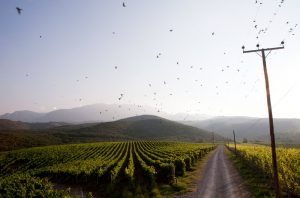Greece emerged in the late-20th century as a serious player in the wine world. It hasn’t looked back since; unique grape varieties and inimitable flavours are seducing oenophiles from London to Hong Kong. Greek wines continue to receive critical acclaim in competitions, as new and experimental styles emerge, and the focus on sustainable viticulture grows. At the same time, Greek producers never forget their roots – this proud nation gave birth to Europe’s first definitive wine culture.
Today, wine remains one of the most important parts of the Greek economy, increasingly driven by exports and international sales. And with good reason; the best Greek wines, nearly always produced from indigenous grapes, have few peers. Indeed, the country boasts 33 appellations or Protected Designations of Origin (PDO), and 114 Protected Geographical Indications (PGI), as well as the newly introduced Varietal Wines category.
Character, diversity, identity
For the wine lover, the only dilemma is knowing where to start. Over 300 different indigenous red and white varieties are being grown today, some of which are already widely known. Assyrtiko needs little if any introduction; grown on Santorini, Crete and the Aegean islands is the dominant variety in PDO Santorini (ΠΟΠ Σαντορίνη) wines. Roditis produces – along with other indigenous and international grapes – Varietal Wines, PDO Anchialos (ΠΟΠ Αγχίαλος) in Thessaly and PDO Patra (ΠΟΠ Πάτρα) in the northern Peloponnese. Mavrodaphne is spotlighted, in combination with Corinthian Black, in PDO Mavrodaphne of Cephalonia (ΠΟΠ Μαυροδάφνη Κεφαλληνίας) and PDO Mavrodaphne of Patra (ΠΟΠ Μαυροδάφνη Πατρών). And the Liatiko variety accounts for 80% of the blends in PDO Dafnes (ΠΟΠ Δαφνές), as well as featuring in several other Cretan PDO reds and Varietal Wines.
Greece’s mosaic of diverse terroirs is no less impressive, encompassing the islands of Cephalonia, Crete and the Cyclades, as well as Macedonia and the vast expanse of the Peloponnese. The white grape Assyrtiko is the country’s most internationally renowned, offering gorgeous fruit and floral aromatics. Once only known to islanders and visitors, Assyrtiko is now becoming a household name. The grape can offer diverse styles, ranging from zesty expressions, fermented in stainless steel, to skin-contact wines with powerful aromas of lanolin and acacia.
But the better-known grapes are just the beginning. Leap headfirst into the esoteric Malagousia, with its signature scents of peach and Darjeeling and you’re bound to impress dinner guests. Try it alongside a selection of indigenous and international grape varieties in a PDO Rhodes (ΠΟΠ Ρόδος) or one of the PGI wines of mainland Greece. Meanwhile, Cephalonia delights tourists with the top-quality floral grape Robola; a wonderful alternative to the ubiquitous Sauvignon Blanc, showcased in Varietal Wines and the PDO Robola of Kefalonia (ΠΟΠ Ρομπόλα Κεφαλληνίας).

Of the reds, Agiorgitiko (the only grape of PDO Nemea (ΠΟΠ Νεμέα) from the Peloponnese) and Xinomavro (the star of Macedonia’s flagship PDOs, namely PDOs Naoussa (ΠΟΠ Νάουσα) and Amyndeon (ΠΟΠ Αμύνταιο)) are two standouts, combining force and finesse to spectacular effect. There are also real curiosities to discover; Mavrotragano faced extinction in the 20th century – due to its less than reliable yields – however, its fortunes have been revived on the island of Santorini. Here, it produces opulent and fruit-forward reds under the PGI Cyclades (ΠΓΕ Κυκλάδες), which deserve the finest culinary pairings. And despite the warm climate in which they grow, the wines are never aggressively alcoholic, with freshness and acidity used to balance out Mavrotragano’s inherent power.
To greater, unexpected, heights
One fact often surprises newcomers to Greek wine, who ask how such a sunny climate can produce saline, mineral-infused whites and fresh reds. The answer is altitude. Many of Greece’s best vineyards are planted at high elevations, affording all the benefits of wide diurnal temperature variation – a significant difference between day and night temperatures.
A valued commodity in many successful regions, a wide diurnal range is responsible for slowing the vine’s metabolism after sunset as the temperature drops, maintaining acidity and freshness in the wines. The nation’s Mediterranean climate ensures that fungal diseases are rarely a major concern. Many producers are now adopting organic and low-intervention viticulture, producing higher-quality wines with less impact on the environment. Ναι, modern Greek wines are a revelation, and are set to conquer the world.

Discover more about the Wines of Greece








